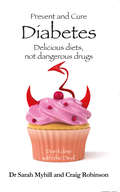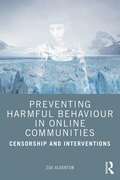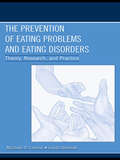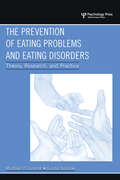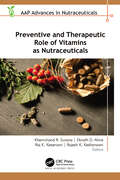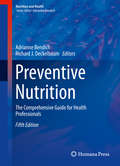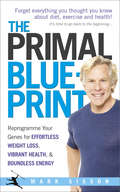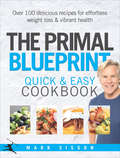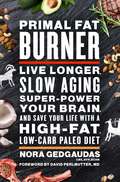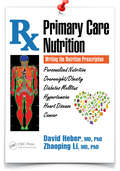- Table View
- List View
Pressure Cookers For Dummies
by Tom LacalamitaThe stress-free way to cook under pressure In today's "hurry-up" society, pressure cooking is an attractive means of preparing consistent, convenient everyday meals. Increasing health concerns coupled with a continuously rising cost of living have made pressure cooking more popular as a way to save money and eat healthier at home. This revised edition of Pressure Cookers For Dummies includes all new recipes and refreshed content. Pressure Cookers For Dummies gives you the lowdown on the different pressure cooker options that are available to make sure you get the pressure cooker best equipped to suit your needs. It includes delicious recipes for dishes such as soups, chilis, and stews; roasts and poultry; rice dishes; beans; vegetables; and desserts, jams, and compotes. It also offers a wealth of recipes for those on vegan, vegetarian, gluten-free, and lactose-free diets. Pressure Cookers For Dummies offers tips on adapting your favorite recipes for the pressure cooker plus several comparison recipes made the traditional way. Every recipe Includes preparation times, cooking times, and nutritional information. Updated expert advice on choosing the best pressure cooker for your kitchen, including coverage of electric cookers Explanations on how pressure cookers work and tips on adapting your favorite recipes for the pressure cooker Shows you how to use pressure cookers to create vegetarian, vegan, special diet, and sustainable dishes with flavor and zest; and incorporate ethnic dishes into your pressure cooker repertoire Includes fun, tasty, and easy recipes for holidays and other occasions that the whole family will enjoy If you're a new or seasoned cook, Pressure Cookers For Dummies gives you everything you need to make the most of this time-saving appliance.
Pressure Cooking Every Day: 80 modern recipes for stovetop pressure cooking
by Denise SmartFeaturing 80 fresh, easy-to-make modern recipes, such as Huevos rancheros, Lentil and cauliflower curry and Baked salted caramel cheese cake, Pressure Cooker Everyday gives this traditional way of cooking a new lease of life. Save time in the kitchen, cut costs and infuse your food with more intense flavours. Discover the potential of pressure cooking with this must-have cookbook.Six reasons to use a stovetop pressure cooker:1. Super quick - cooks three times faster than conventional cooking.2. Convenience - delicious meals, using just one pot. 3. Economical - ideal for cooking cheap ingredients from scratch.4. Durability - electric pressure cookers last years, but stovetop cookers last a lifetime.5. Versatility - they allow you to tweak recipes as you go along. You can also sear or sauté food before pressure cooking it, adding flavour, which electric cookers fail to achieve.6. More power - stovetop pressure cookers reach higher heat and pressure than electrical ones.
Pressure Cooking Properly Explained: Save time and money with your pressure cooker
by Dianne PageWhether you've just bought your first pressure cooker, or you have left your old one languishing at the back of the cupboard for a while, Dianne Page will help you get the most out of this most useful piece of kitchen equipment.Pressure cooking cuts conventional cooking times to a third. Soups can be ready in minutes. Favourite recipes, which traditionally take hours to prepare, can be cooked and enjoyed at the end of a busy day. Plus shorter cooking times mean lower gas and electricity bills.Other benefits include:- Food retains its flavour, vitamins, minerals and colour- Cheaper cuts of meat - that are packed with flavour but normally need long slow cooking to make them tender - can be cooked quickly- Less steam is produced so no condensation in the kitchen
Pretty Happy: The Healthy Way To Love Your Body
by Kate HudsonA smart health and fitness bible from inspirational actress Kate Hudson.
Pretty Happy: The Healthy Way To Love Your Body
by Kate HudsonA smart health and fitness bible from inspirational actress Kate Hudson.
Prevent and Cure Diabetes: Delicious Diets, Not Dangerous Drugs: Don't Dine With The Devil
by Sarah Myhill Craig RobinsonWe are probably all aware that countries with the Western lifestyle and the standard Western diet are facing an epidemic of type 2 diabetes. Already in 2010, more than one million people in the UK were thought to have undiagnosed type 2 diabetes, double the previous estimate, and as long ago as 2008 between 20% and 30% of the adult population could be characterised as having the ‘metabolic syndrome’ – the forerunner to diabetes. The tragedy is that most people with these conditions regard them as inevitable evils and agree to take the medicine – or inject the insulin – when the time comes. BUT it need not be that way. As Dr Myhill writes: ‘All medical therapies should start with diet. Modern Western diets are driving our modern epidemics of diabetes, heart disease, cancer and dementia; this process is called metabolic syndrome. In this book I explain in detail why and how we have arrived at a situation where the real weapons of mass destruction can be found in our kitchens. Importantly, the book describes the vital steps every one of us can make to reverse the situation so that life can be lived to its full potential.’ Based on Dr Myhill’s more than 30 years’ experience of helping her patients return to health, find out: What metabolic syndrome is, why Westerners are all on the way to getting it, and how to avoid it; What the risk factors are for developing diabetes and how to minimise these; How to reverse diabetes type 2; How to control blood sugar with minimal use of insulin in diabetes type 1; How to balance your blood sugar levels and monitor your progress.
Preventing Harmful Behaviour in Online Communities: Censorship and Interventions
by Zoe AldertonPreventing Harmful Behaviour in Online Communities explores the ethics and logistics of censoring problematic communications online that might encourage a person to engage in harmful behaviour. Using an approach based on theories of digital rhetoric and close primary source analysis, Zoe Alderton draws on group dynamics research in relation to the way in which some online communities foster negative and destructive ideas, encouraging community members to engage in practices including self-harm, disordered eating, and suicide. This book offers insight into the dangerous gap between the clinical community and caregivers versus the pro-anorexia and pro-self-harm communities – allowing caregivers or medical professionals to understand hidden online communities young people in their care may be part of. It delves into the often-unanticipated needs of those who band together to resist the healthcare community, suggesting practical ways to address their concerns and encourage healing. Chapters investigate the alarming ease with which ideas of self-harm can infect people through personal contact, community unease, or even fiction and song and the potential of the internet to transmit self-harmful ideas across countries and even periods of time. The book also outlines the real nature of harm-based communities online, examining both their appeal and dangers, while also examining self-censorship and intervention methods for dealing with harmful content online. Rather than pointing to punishment or censorship as best practice, the book offers constructive guidelines that outline a more holistic approach based on the validity of expressing negative mood and the creation of safe peer support networks, making it ideal reading for professionals protecting vulnerable people, as well as students and academics in psychology, mental health, and social care.
Preventing Harmful Behaviour in Online Communities: Censorship and Interventions
by Zoe AldertonPreventing Harmful Behaviour in Online Communities explores the ethics and logistics of censoring problematic communications online that might encourage a person to engage in harmful behaviour. Using an approach based on theories of digital rhetoric and close primary source analysis, Zoe Alderton draws on group dynamics research in relation to the way in which some online communities foster negative and destructive ideas, encouraging community members to engage in practices including self-harm, disordered eating, and suicide. This book offers insight into the dangerous gap between the clinical community and caregivers versus the pro-anorexia and pro-self-harm communities – allowing caregivers or medical professionals to understand hidden online communities young people in their care may be part of. It delves into the often-unanticipated needs of those who band together to resist the healthcare community, suggesting practical ways to address their concerns and encourage healing. Chapters investigate the alarming ease with which ideas of self-harm can infect people through personal contact, community unease, or even fiction and song and the potential of the internet to transmit self-harmful ideas across countries and even periods of time. The book also outlines the real nature of harm-based communities online, examining both their appeal and dangers, while also examining self-censorship and intervention methods for dealing with harmful content online. Rather than pointing to punishment or censorship as best practice, the book offers constructive guidelines that outline a more holistic approach based on the validity of expressing negative mood and the creation of safe peer support networks, making it ideal reading for professionals protecting vulnerable people, as well as students and academics in psychology, mental health, and social care.
Prevention and Treatment of Cardiovascular Disease: Nutritional and Dietary Approaches (Contemporary Cardiology)
by Michael J. Wilkinson Michael S. Garshick Pam R. TaubThis book discusses all aspects of non-pharmacologic approaches to primary and secondary CVD prevention. It highlights the strength of evidence for particular diet styles in CVD prevention, including plant-based diets, the Mediterranean diet, the DASH diet, and low-carbohydrate diets. Chapters present evidence and future directions for diet and nutrition in diseases related to CVD, such as dyslipidemia, cardiometabolic disease (pre-diabetes, the metabolic syndrome, type-2 diabetes mellitus), and obesity. Finally, the book reviews novel and emerging aspects of dietary intervention in CVD prevention, such as dietary approaches to inflammation and the role of the microbiome in CVD. Up-to-date, evidence-based, and clinically oriented, Prevention and Treatment of Cardiovascular Disease: Nutritional and Dietary Approaches is an essential resource for physicians, residents, fellows, and medical students in cardiology, clinical nutrition, family medicine, endocrinology, and lipidology.
The Prevention of Eating Problems and Eating Disorders: Theory, Research, and Practice
by Michael P. Levine Linda SmolakThis is the first authored volume to offer a detailed, integrated analysis of the field of eating problems and disorders with theory, research, and practical experience from community and developmental psychology, public health, psychiatry, and dietetics. The book highlights connections between the prevention of eating problems and disorders and theory and research in the areas of prevention and health promotion; theoretical models of risk development and prevention (e.g., developmental psychopathology, social cognitive theory, feminist theory, ecological approaches); and related research on the prevention of smoking and alcohol use. It is the most comprehensive book available on the study of prevention programs, especially for children and adolescents.The authors review the spectrum of eating problems and disorders, the related risk and protective factors, the models that have guided prevention efforts to date, the literature on the studies of prevention, and suggestions for curriculum and program development and evaluation. The book concludes with a new prevention program based on the Feminist Ecological Developmental model. The 800 + references highlight work done around the world.The Prevention of Eating Problems and Eating Disorders addresses: * methodologies for assessing and establishing prevention;* the implications of neuroscience for prevention;* dramatic increases in the incidence of obesity;* the role of boys, men, and the media on body image;* prevention programming for minority groups; and* whether to focus on primary or secondary prevention.Intended for clinicians and academicians from disciplines such as health, clinical, developmental, and community psychology; social work; medicine; and public health; this book is also an ideal text for advanced courses on eating disorders.
The Prevention of Eating Problems and Eating Disorders: Theory, Research, and Practice
by Michael P. Levine Linda SmolakThis is the first authored volume to offer a detailed, integrated analysis of the field of eating problems and disorders with theory, research, and practical experience from community and developmental psychology, public health, psychiatry, and dietetics. The book highlights connections between the prevention of eating problems and disorders and theory and research in the areas of prevention and health promotion; theoretical models of risk development and prevention (e.g., developmental psychopathology, social cognitive theory, feminist theory, ecological approaches); and related research on the prevention of smoking and alcohol use. It is the most comprehensive book available on the study of prevention programs, especially for children and adolescents.The authors review the spectrum of eating problems and disorders, the related risk and protective factors, the models that have guided prevention efforts to date, the literature on the studies of prevention, and suggestions for curriculum and program development and evaluation. The book concludes with a new prevention program based on the Feminist Ecological Developmental model. The 800 + references highlight work done around the world.The Prevention of Eating Problems and Eating Disorders addresses: * methodologies for assessing and establishing prevention;* the implications of neuroscience for prevention;* dramatic increases in the incidence of obesity;* the role of boys, men, and the media on body image;* prevention programming for minority groups; and* whether to focus on primary or secondary prevention.Intended for clinicians and academicians from disciplines such as health, clinical, developmental, and community psychology; social work; medicine; and public health; this book is also an ideal text for advanced courses on eating disorders.
Prevention of the Biological Contamination of Food: Processing/Distribution and Consumer Usage
by Thierry Bénézech Christine FailleThis book deals with risk management by focusing on microbiological risks. Throughout the food chain, foodstuff may be exposed to dangerous agents that can potentially affect its quality and thus the health of consumers. A good knowledge of the strategies and means of control implemented along the food chain after the primary production stage is a necessary condition and a prerequisite for any further improvement, but it is not sufficient. Indeed, in order to better prevent and therefore control these risks, it is essential to study both the phenomena of surface contamination and those relating to the elimination of this contamination by cleaning and disinfection operations in order to know the main mechanisms. Thanks to this, a certain number of innovations can already be proposed (new surfaces, new materials and cleaning and disinfection procedures, etc.) for future developments on an industrial or domestic scale.
Prevention of the Biological Contamination of Food: Processing/Distribution and Consumer Usage
by Thierry Bénézech Christine FailleThis book deals with risk management by focusing on microbiological risks. Throughout the food chain, foodstuff may be exposed to dangerous agents that can potentially affect its quality and thus the health of consumers. A good knowledge of the strategies and means of control implemented along the food chain after the primary production stage is a necessary condition and a prerequisite for any further improvement, but it is not sufficient. Indeed, in order to better prevent and therefore control these risks, it is essential to study both the phenomena of surface contamination and those relating to the elimination of this contamination by cleaning and disinfection operations in order to know the main mechanisms. Thanks to this, a certain number of innovations can already be proposed (new surfaces, new materials and cleaning and disinfection procedures, etc.) for future developments on an industrial or domestic scale.
Preventive and Therapeutic Role of Vitamins as Nutraceuticals (AAP Advances in Nutraceuticals)
by Khemchand R. Surana Eknath D. Ahire Raj K. Keservani Rajesh K. KesharwaniThis new book provides informative coverage of recent breakthroughs in vitamins and their ability to prevent disease, manage health issues, and treat chronic illness. It describes the beneficial effects of vitamins as nutraceuticals in treating cancer, for improving the immunity of patients with HIV and AIDS, for the treatment of tuberculosis, and for the management of infectious diseases, such as viral infections, microbial infections, and COVID-19. The functional activity of vitamins in brain health and obesity management is also explored for the management, prevention, and delay of hypertension and related problems. The volume also covers vitamins that play a role in neurodegenerative diseases as well as those that can be used for weight loss and obesity, blindness and vision issues, baldness, and skincare issues.
Preventive and Therapeutic Role of Vitamins as Nutraceuticals (AAP Advances in Nutraceuticals)
This new book provides informative coverage of recent breakthroughs in vitamins and their ability to prevent disease, manage health issues, and treat chronic illness. It describes the beneficial effects of vitamins as nutraceuticals in treating cancer, for improving the immunity of patients with HIV and AIDS, for the treatment of tuberculosis, and for the management of infectious diseases, such as viral infections, microbial infections, and COVID-19. The functional activity of vitamins in brain health and obesity management is also explored for the management, prevention, and delay of hypertension and related problems. The volume also covers vitamins that play a role in neurodegenerative diseases as well as those that can be used for weight loss and obesity, blindness and vision issues, baldness, and skincare issues.
Preventive Nutrition: The Comprehensive Guide for Health Professionals (Nutrition and Health)
by Adrianne Bendich Richard J. DeckelbaumEvidence-based nutritional interventions are now a critical component of preventive medicine, employed in a wide variety of medical scenarios. Preventive Nutrition: A Comprehensive Guide for Health Professionals, Fourth Edition gives health professionals up-to-date, comprehensive reviews that evaluate the dietary practices and interventions that have been shown to reduce disease risk and improve health outcomes. This is the flagship volume for the book series, Nutrition and Health, which has become an essential tool for health professionals. As the state of global health and nutrition have changed much since the publication of the Third Edition, this major revised and expanded Fourth Edition includes newly authored chapters and features analysis of the results of the Women’s Health Initiative, the largest intervention study ever undertaken and completed in postmenopausal women. Other new material includes chapters reviewing the evidence concerning econutrition, micronutrients and major cancers, and cognitive function and other mental health areas. Also discussed are the importance of gastric acid secretions, the nutritional effects of current therapies, and the latest information on the biology of obesity and its relationship to Type 2 diabetes. One key new feature of this edition is a chapter on behavioral strategies to help assure compliance with dietary regimes, maximizing the health benefits of preventive nutrition. The authors have created the most comprehensive and up-to-date review of the nutritional strategies available for the prevention of disease and the promotion of health through nutrition. Patients are looking for credible information from their health care providers about a whole range of subjects covered here, including ß-carotene, lycopene, antioxidants, folate, and the myriad of bioactive phytochemicals found in garlic and other foods. With sections on cardiovascular disease, diabetes, and pregnancy among many others, this volume will be of great value to practicing health professionals, including physicians, nutritionists, dentists, pharmacists, dieticians, health educators, policy makers, health economists, regulatory agencies and research investigators. An entire section covers nutrition transitions around the world including Eastern Europe, Latin America and Asia as well as goals for preventive nutrition in developing countries.
Preventive Nutrition: The Comprehensive Guide for Health Professionals (Nutrition and Health)
by Adrianne Bendich Richard J. DeckelbaumThis newly expanded and updated fifth edition will be the largest and most comprehensive of the five editions and new topics and chapter authors have been added. The authors have created the most comprehensive and up-to-date review of the nutritional strategies available for the prevention of disease and the promotion of health through nutrition. Patients are looking for credible information from their health care providers about a whole range of subjects covered here, including ß-carotene, lycopene, antioxidants, folate, and the myriad of bioactive phytochemicals found in garlic and other foods. With sections on cardiovascular disease, diabetes, and pregnancy among many others, this volume will be of great value to practicing health professionals, including physicians, nutritionists, dentists, pharmacists, dieticians, health educators, policy makers, health economists, regulatory agencies and research investigators. An entire section covers nutrition transitions around the world including Eastern Europe, Latin America and Asia as well as goals for preventive nutrition in developing countries. Preventive Nutrition: The Comprehensive Guide for Health Professionals, 5th Ed. is an important resource for thousands of health professionals who have been utilizing the previous editions since 1997.
Preventive Nutrition: The Comprehensive Guide for Health Professionals (Nutrition and Health)
by Adrianne Bendich Richhard J. DeckelbaumIn this major revision and expansion of a highly respected reference work, the authors have created the most comprehensive and up-to-date review of the nutritional strategies available for the prevention of disease and the promotion of health through nutrition. This new edition combines fully updated versions of the best chapters of the first two editions with updated critical chapters from the much-praised Primary and Secondary Preventive Nutrition, and adds 16 new chapters. Here, practicing health professionals will find all new reviews of lycopene, tomatoes and prostate cancer, soy and cancer prevention; the effects of dietary supplement use on prescription drugs, osteoarthritis, osteoporosis, and cardiovascular disease; balanced, data-driven reviews of the effects of antioxidant supplements on health outcomes, and more. By synthesizing the latest data and integrating it into the broad body of existing information, this book provides in-depth guidance on nutrition and the prevention of cancer, cardiovascular disease, bone diseases, obesity, and diabetes, and on achieving optimal pregnancies and birth outcomes.
The Primal Blueprint: Reprogramme your genes for effortless weight loss, vibrant health and boundless energy
by Mark SissonIf you want to reach your physical and genetic potential Mark Sisson's 10 Primal Blueprint Laws will get you real results. Combining evolutionary biology with modern genetic science, Mark Sisson takes you back to basics and explains what you need to do to get the body and health you want - with the minimum amount of effort. Mark's approach works by adapting the simple practices of our early ancestors to our modern lifestyles. These include: eating a high-protein, high-fat diet with plenty of vegetables; exercising less for the best results; eliminating sugar and grains; improving quality of sleep; and spending more time outside. The 10 Primal Blueprint Laws will help you:- Lose weight quickly and easily- Increase your energy levels- Get a strong, fit, lean body- Sleep soundly- Improve cholesterol and blood sugar - Enjoy vibrant health This is an empowering and enlightening book that will help you stop struggling with your weight and give you back control of your health - and your future.
The Primal Blueprint Quick and Easy Cookbook: Over 100 delicious recipes for effortless weight loss and vibrant health
by Mark SissonHot on the heels of the phenomenal success of The Primal Blueprint and in response to the growing demand for easy and healthy meals comes this fabulous primal cookbook. Fully Anglicised and packed with over 100 recipes, it will help you make the transition with ease from a grain-based diet to a Primal Blueprint diet. Mark Sisson’s mouth-watering recipes include: Bacon Soufflé Frittata, Dill and Caper Salmon Burgers, Tahini Chicken Salad, Berry Crumble and Cinnamon Walnut Crackers.- Eat fabulous food and lose weight quickly and easily- Increase daily energy levels- Burn fat and improve cholesterol and blood sugar- Cook delicious dishes in 30 minutes or lessWith innovative ideas for breakfast, lunch and dinner, as well as appetisers, snacks and sauces, you can eat amazing food every day and still lose weight. Includes over 300 colour photographs.First published by the author as Primal Blueprint: Quick and Easy Meals.
Primal Fat Burner: Live Longer, Slow Aging, Super-Power Your Brain and Save Your Life With a High-Fat, Low-Carb Paleo Diet
by Nora GedgaudasPopular nutritionist Nora Gedguadas returns with advice that may sound counterintuitive: eat fat to burn fat. In Primal Fat Burner she explains the benefits and science behind a ketogenic (or fat-burning) diet, which switches your metabolism from a dependence on sugar to running on healthy fats. As Gedgaudas reveals, numerous studies in recent years refute the long-promoted anti-saturated fat and anti-cholesterol agenda. Now Gedgaudas explains the science that fat isn't a 'no-no' but rather a 'yes-yes' - if you know the right kinds of fats to eat. In her accessible, enjoyable style, she also lays out a practical meal plan with recipes. When you follow a ketogenic diet, you consume fewer calories overall!Author of the bestselling Grain Brain, Dr. David Perlmutter writes in his foreword that Primal Fat Burner is 'wonderfully actionable, compassionately taking the reader from "why" to "how."' On this diet, you efficiently and effectively metabolise fat (ketones and free fatty acids) as your primary source of fuel, rather than glucose from carbs, starches and sugars. Because fat is so satisfying, you naturally wind up eating less - without feelings of hunger or deprivation. And natural dietary fat is ultimately key to optimum health and longevity.Gedgaudas communicates a real appreciation for and understanding of the central role that dietary fat plays in your body and brain, and explains how you can eat to feel better, look better, think clearer and live longer.
Primary and Secondary Preventive Nutrition (Nutrition and Health)
by Adrianne Bendich Richard J. DeckelbaumThe Nutrition and Health series has been very fortunate to have each of the volumes recognized by rating services, such as Doody's, as valuable contributions for health professionals and individuals interested in the most up-to-date and balanced information from the experts in nutrition. These independent accolades may have occurred because the Nutrition and Health series has as its overriding mission to provide health profession als with texts that are considered essential because each book includes: (1) a synthesis of the state of the science, (2) timely, in-depth reviews by the leading researchers in their respective fields, (3) extensive, up-to-date fully annotated reference lists, (4) a detailed index, (5) relevant tables and figures, (6) identification of paradigm shifts and the con sequences, (7) virtually no overlap of information between chapters, but targeted, inter chapterreferrals, (8) suggestions of areas for future research, and (9) balanced, data-driven answers to patient questions, which are based upon the totality of evidence rather than the findings of any single study. The series volumes are not the outcome of a symposium. Rather, each editor has the potential to examine a chosen area with a broad perspective, both in subject matter as well as in the choice of chapter authors. The international perspective, especially with regard to public health initiatives, is emphasized where appropriate.
Primary Care Nutrition: Writing the Nutrition Prescription
by David Heber Zhaoping LiThis book contains the necessary knowledge and tools to incorporate nutrition into primary care practice. As a practical matter, this effort is led by a dedicated primary care physician with the help of motivated registered dietitians, nurses, psychologists, physical therapists, and office staff whether within a known practice or by referral to the community. It is essential that the nutrition prescription provided by the physician be as efficient as possible. While many team members have superior knowledge in the areas of nutrition, exercise, and psychology, the health practitioner remains the focus of patient confidence in a therapy plan. Therefore, the endorsement of the plan rather than the implementation of the plan is the most important task of the physician. This book proposes a significant change in attitude of primary health care providers in terms of the power of nutrition in prevention and treatment of common disease. It features detailed and referenced information on the role of nutrition in the most common conditions encountered in primary care practice. In the past, treatment focused primarily on drugs and surgery for the treatment of disease with nutrition as an afterthought. Advanced technologies and drugs are effective for the treatment of acute disease, but many of the most common diseases such as heart disease, diabetes, and cancer are not preventable with drugs and surgery. While there is mention of prevention of heart disease, this largely relates to the use of statins with some modest discussion of a healthy diet. Similarly, prevention of type 2 diabetes is the early introduction of metformin or intensive insulin therapy.
Primary Care Nutrition: Writing the Nutrition Prescription
by David Heber Zhaoping LiThis book contains the necessary knowledge and tools to incorporate nutrition into primary care practice. As a practical matter, this effort is led by a dedicated primary care physician with the help of motivated registered dietitians, nurses, psychologists, physical therapists, and office staff whether within a known practice or by referral to the community. It is essential that the nutrition prescription provided by the physician be as efficient as possible. While many team members have superior knowledge in the areas of nutrition, exercise, and psychology, the health practitioner remains the focus of patient confidence in a therapy plan. Therefore, the endorsement of the plan rather than the implementation of the plan is the most important task of the physician. This book proposes a significant change in attitude of primary health care providers in terms of the power of nutrition in prevention and treatment of common disease. It features detailed and referenced information on the role of nutrition in the most common conditions encountered in primary care practice. In the past, treatment focused primarily on drugs and surgery for the treatment of disease with nutrition as an afterthought. Advanced technologies and drugs are effective for the treatment of acute disease, but many of the most common diseases such as heart disease, diabetes, and cancer are not preventable with drugs and surgery. While there is mention of prevention of heart disease, this largely relates to the use of statins with some modest discussion of a healthy diet. Similarly, prevention of type 2 diabetes is the early introduction of metformin or intensive insulin therapy.
Primary Care Nutrition: Writing the Nutrition Prescription
by David Heber Zhaoping LiThis book contains the necessary knowledge and tools to incorporate nutrition into primary care practice. As a practical matter, this effort is led by a dedicated primary care physician with the help of motivated registered dietitians, nurses, psychologists, physical therapists, and office staff whether within a known practice or by referral to the community. It is essential that the nutrition prescription provided by the physician be as efficient as possible. While many team members have superior knowledge in the areas of nutrition, exercise, and psychology, the health practitioner remains the focus of patient confidence in a therapy plan. Therefore, the endorsement of the plan rather than the implementation of the plan is the most important task of the physician. This book proposes a significant change in attitude of primary health care providers in terms of the power of nutrition in prevention and treatment of common disease. It features detailed and referenced information on the role of nutrition in the most common conditions encountered in primary care practice. In the past, treatment focused primarily on drugs and surgery for the treatment of disease with nutrition as an afterthought. Advanced technologies and drugs are effective for the treatment of acute disease, but many of the most common diseases such as heart disease, diabetes, and cancer are not preventable with drugs and surgery. While there is mention of prevention of heart disease, this largely relates to the use of statins with some modest discussion of a healthy diet. Similarly, prevention of type 2 diabetes is the early introduction of metformin or intensive insulin therapy.





